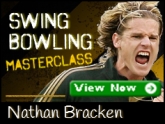|

One of Bob Woolmer's batting drills was the one-legged drive which I featured right at the start of the Coaching to Win series.
This gem of a drill helps players who lead their forward movement to the ball with their heads. (Not your Pietersen, Amla or Gayle who lead with their feet but more like the Bell, Ponting and Strauss).
Bob would ask the batter to not move their feet, yet wait for the fuller ball to bounce and move their head towards the line of the ball.
What does this drill develop?
Late contact
Because the batter can't step forward into the ball, the more advanced head position encourages the player to let the ball come all the way up to him before making contact.
We now know that any player who leads with his head needs to make later contacts in order to control the ball and gain maximal power in his shots.
This drill encourages late contact. So if you have a player who tends to hit the ball too early then this one for them.
Tracking the ball into contact
7 out of 8 batting dismissals occur through error in visual perception. The batter is:
- not focusing on the ball optimally
- has not been able to watch the ball into contact effectively
- struggled to access the ball with their most preferred motion tracking eye
Guys like Bell and Strauss need to track the ball into contact by playing with their heads down. Coaches will notice that the top of the helmet rather than the grill will be most prevalent when the ball is struck crisply.
This allows the batter to track the ball all the way into contact. If the head doesn't lead and doesn't nod the ball into contact their their field of vision will be looking above the height of the incoming ball. If you can't track the ball in its last couple of yards then effectively, we are playing blind.
Increased timing
Players will report that they are surprised how much power they can generate considering their lack of foot movement.
By letting the ball reach them, many players will be able to use the pace of the ball, are able to meet the ball with a square bat face and as a result they will feel the the sensation of timing.
Drill progression
After a while, the batter will have mastered the techniques of:
- an exaggerated head lead
- -nodding the head into contact
- -making late contact.
These are all good things for players that lead their forward movement with their head.
The drill progression is to retain these elements of technique and then add in foot movement.
Ensure that the player understands that the foot is only there to stop them from losing balance rather than to reach the place on the pitch where the ball bounces.
The final result
- Increased timing
- Increased control of the contact zone
- Increased timing
- Repeatable performance
Give it a go in throw down sessions, using bobble feeds and as part of your bowling machine practices.
Discuss this article with other subscribers
|

.jpg)




.jpg)


